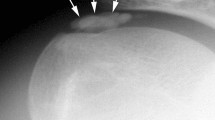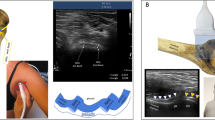Abstract
Purpose
To assess patients with and without postoperative residual pain and to compare clinical function and magnetic resonance imaging (MRI) appearance of the repaired supraspinatus tendon between patients with and without pain.
Methods
One-hundred and seventeen patients with supraspinatus tear were included in this study. Visual Analog Scale (VAS) scores for pain were assessed at a follow-up of at least 1 year. Patients with residual shoulder pain were enrolled in the residual pain group (RP group) and patients without pain enrolled in the no pain group (NP group). The American Shoulder and Elbow Surgeons (ASES) shoulder evaluation form, the modified University of California at Los Angeles (UCLA) score and the Fudan University Shoulder Score (FUSS) were also used to evaluate shoulder function. MRI examinations were performed to evaluate rotator cuff integrity according to the Sugaya method, and muscular hypotrophy, fatty infiltration, and signal/noise quotient (SNQ) of the rotator cuff tendon.
Results
Thirty-five patients had residual pain (RP group) and 82 patients had no pain (NR group). At the final follow-up, there was a significant difference in ASES (92 ± 8 points vs 76 ± 10 points; p < 0.001), UCLA (32 ± 3 points vs 28 ± 3 points; p < 0.001), FUSS (90 ± 7 points vs 80 ± 9 points; p < 0.001) and strength (9 ± 3 kg vs 6 ± 2 kg; p < 0.001) between the NP group and the RP group, respectively. Postoperative MRI revealed that there was no significant difference in the retear rate (9.8% vs 8.6%; ns), the muscular hypotrophy (ns), and the fatty infiltration index (0.9 ± 0.2 vs 0.9 ± 0.2; ns) between the NP and the RP groups, respectively. The postoperative tendon SNQ of the RP group was significantly higher than that of the NP group (4.6 ± 2.5 vs 3 ± 1.7; p < 0.001). There was a significant association between tendon SNQ and VAS for this cohort (\( \rho\) = 0.29; p = 0.003).
Conclusion
Postoperative residual pain is associated with a high MRI signal intensity of the repaired supraspinatus tendon. Since high signal intensity of tendon tissue indicates degenerated tendon tissue quality, it highlighted the necessity of debriding the degenerated rotator cuff tendon tissue.
Level of evidence
III.




Similar content being viewed by others
References
Aydin N, Kocaoglu B, Guven O (2010) Single-row versus double-row arthroscopic rotator cuff repair in small- to medium-sized tears. J Shoulder Elb Surg 19(5):722–725
Barber FA (2016) Triple-loaded single-row versus suture-bridge double-row rotator cuff tendon repair with platelet-rich plasma fibrin membrane: a randomized controlled trial. Arthroscopy 32(5):753–761
Blaine TA, Cote MA, Proto A, Mulcahey M, Lee FY, Bigliani LU (2011) Interleukin-1beta stimulates stromal-derived factor-1alpha expression in human subacromial bursa. J Orthop Res 29(11):1695–1699
Blaine TA, Kim YS, Voloshin I, Chen D, Murakami K, Chang SS, Winchester R, Lee FY, O’Keefe RJ, Bigliani LU (2005) The molecular pathophysiology of subacromial bursitis in rotator cuff disease. J Shoulder Elb Surg 14(1 Suppl S):84S–89S
Boileau P, Brassart N, Watkinson DJ, Carles M, Hatzidakis AM, Krishnan SG (2005) Arthroscopic repair of full-thickness tears of the supraspinatus: does the tendon really heal? J Bone Jt Surg Am 87(6):1229–1240
Boyer P, Bouthors C, Delcourt T, Stewart O, Hamida F, Mylle G, Massin P (2015) Arthroscopic double-row cuff repair with suture-bridging: a structural and functional comparison of two techniques. Knee Surg Sports Traumatol Arthrosc 23(2):478–486
Charousset C, Bellaiche L, Kalra K, Petrover D (2010) Arthroscopic repair of full-thickness rotator cuff tears: is there tendon healing in patients aged 65 years or older? Arthroscopy 26(3):302–309
Chen Y, Li H, Qiao Y, Ge Y, Li Y, Hua Y, Chen J, Chen S (2019) Double-row rotator cuff repairs lead to more intensive pain during the early postoperative period but have a lower risk of residual pain than single-row repairs. Knee Surg Sports Traumatol Arthrosc. https://doi.org/10.1007/s00167-019-05346-0
Constant CR, Murley AH (1987) A clinical method of functional assessment of the shoulder. Clin Orthop Relat Res 214:160–164
Crim J, Burks R, Manaster BJ, Hanrahan C, Hung M, Greis P (2010) Temporal evolution of MRI findings after arthroscopic rotator cuff repair. AJR Am J Roentgenol 195(6):1361–1366
DeHaan AM, Axelrad TW, Kaye E, Silvestri L, Puskas B, Foster TE (2012) Does double-row rotator cuff repair improve functional outcome of patients compared with single-row technique? A systematic review. Am J Sports Med 40(5):1176–1185
Elliott RSJ, Lim YJ, Coghlan J, Troupis J, Bell S (2019) Structural integrity of rotator cuff at 16 years following repair: good long-term outcomes despite recurrent tears. Shoulder Elb 11(1):26–34
Ellman H, Hanker G, Bayer M (1986) Repair of the rotator cuff. End-result study of factors influencing reconstruction. J Bone Jt Surg Am 68(8):1136–1144
Fehringer EV, Sun J, VanOeveren LS, Keller BK, Matsen FA 3rd (2008) Full-thickness rotator cuff tear prevalence and correlation with function and co-morbidities in patients sixty-five years and older. J Shoulder Elb Surg 17(6):881–885
Franceschi F, Papalia R, Franceschetti E, Palumbo A, Del Buono A, Paciotti M, Maffulli N, Denaro V (2016) Double-row repair lowers the retear risk after accelerated rehabilitation. Am J Sports Med 44(4):948–956
Ge Y, Chen S, Chen J, Hua Y, Li Y (2013) The development and evaluation of a new shoulder scoring system based on the view of patients and physicians: the Fudan University shoulder score. Arthroscopy 29(4):613–622
Gerhardt C, Hug K, Pauly S, Marnitz T, Scheibel M (2012) Arthroscopic single-row modified mason-allen repair versus double-row suture bridge reconstruction for supraspinatus tendon tears: a matched-pair analysis. Am J Sports Med 40(12):2777–2785
Gil JA, Gunaseelan V, DeFroda SF, Brummett CM, Bedi A, Waljee JF (2019) Risk of prolonged opioid use among opioid-naive patients after common shoulder arthroscopy procedures. Am J Sports Med 47(5):1043–1050
Ide J, Karasugi T, Okamoto N, Taniwaki T, Oka K, Mizuta H (2015) Functional and structural comparisons of the arthroscopic knotless double-row suture bridge and single-row repair for anterosuperior rotator cuff tears. J Shoulder Elb Surg 24(10):1544–1554
Jeon YS, Kim RG, Shin SJ (2017) What influence does progression of a nonhealing rotator cuff tear have on shoulder pain and function? Clin Orthop Relat Res 475(6):1596–1604
Khazzam M, Kuhn JE, Mulligan E, Abboud JA, Baumgarten KM, Brophy RH, Jones GL, Miller B, Smith M, Wright RW (2012) Magnetic resonance imaging identification of rotator cuff retears after repair: interobserver and intraobserver agreement. Am J Sports Med 40(8):1722–1727
Kim JH, Hong IT, Ryu KJ, Bong ST, Lee YS, Kim JH (2014) Retear rate in the late postoperative period after arthroscopic rotator cuff repair. Am J Sports Med 42(11):2606–2613
Kim KC, Shin HD, Lee WY, Han SC (2012) Repair integrity and functional outcome after arthroscopic rotator cuff repair: double-row versus suture-bridge technique. Am J Sports Med 40(2):294–299
Lapner PL, Sabri E, Rakhra K, McRae S, Leiter J, Bell K, Macdonald P (2012) A multicenter randomized controlled trial comparing single-row with double-row fixation in arthroscopic rotator cuff repair. J Bone Jt Surg Am 94(14):1249–1257
Lee JE, Park JS, Ryu KN, Rhee YG, Yoon SH, Park SY, Jin W (2015) Repaired supraspinatus tendons in clinically improving patients: early postoperative findings and interval changes on MRI. Korean J Radiol 16(2):363–371
Lee SH, Kim JW, Kim TK, Kweon SH, Kang HJ, Kim SJ, Park JS (2017) Is the arthroscopic suture bridge technique suitable for full-thickness rotator cuff tears of any size? Knee Surg Sports Traumatol Arthrosc 25(7):2138–2146
Lhee SH, Singh AK, Lee DY (2017) Does magnetic resonance imaging appearance of supraspinatus muscle atrophy change after repairing rotator cuff tears? J Shoulder Elb Surg 26(3):416–423
Li H, Chen Y, Chen J, Hua Y, Chen S (2018) Large critical shoulder angle has higher risk of tendon retear after arthroscopic rotator cuff repair. Am J Sports Med 46(8):1892–1900
Malavolta EA, Gracitelli MEC, Assuncao JH, Ferreira Neto AA, Bordalo-Rodrigues M, de Camargo OP (2018) Clinical and structural evaluations of rotator cuff repair with and without added platelet-rich plasma at 5-year follow-up: a prospective randomized study. Am J Sports Med 46(13):3134–3141
Michener LA, McClure PW, Sennett BJ (2002) American Shoulder and Elbow Surgeons Standardized Shoulder Assessment Form, patient self-report section: reliability, validity, and responsiveness. J Shoulder Elb Surg 11(6):587–594
Millett PJ, Warth RJ, Dornan GJ, Lee JT, Spiegl UJ (2014) Clinical and structural outcomes after arthroscopic single-row versus double-row rotator cuff repair: a systematic review and meta-analysis of level I randomized clinical trials. J Shoulder Elb Surg 23(4):586–597
Nam JH, Park S, Lee HR, Kim SH (2018) Outcomes after limited or extensive bursectomy during rotator cuff repair: randomized controlled trial. Arthroscopy 34(12):3167–3174
Nicholas SJ, Lee SJ, Mullaney MJ, Tyler TF, Fukunaga T, Johnson CD, McHugh MP (2016) Functional outcomes after double-row versus single-row rotator cuff repair: a prospective randomized trial. Orthop J Sports Med 4(10):2325967116667398
Ravindra A, Barlow JD, Jones GL, Bishop JY (2018) A prospective evaluation of predictors of pain after arthroscopic rotator cuff repair: psychosocial factors have a stronger association than structural factors. J Shoulder Elb Surg 27(10):1824–1829
Saccomanno MF, Cazzato G, Fodale M, Sircana G, Milano G (2015) Magnetic resonance imaging criteria for the assessment of the rotator cuff after repair: a systematic review. Knee Surg Sports Traumatol Arthrosc 23(2):423–442
Saito M, Tsukada S, Fujita N, Rahman M, Morita W, Kitamura N, Tasaki A (2018) Post-operative pain control following arthroscopic rotator cuff repair: peri-articular injection versus interscalene brachial plexus block. Int Orthop. https://doi.org/10.1007/s00264-018-4096-3
Shin SJ, Do NH, Lee J, Ko YW (2016) Efficacy of a Subacromial Corticosteroid Injection for Persistent Pain After Arthroscopic Rotator Cuff Repair. Am J Sports Med 44(9):2231–2236
Spielmann AL, Forster BB, Kokan P, Hawkins RH, Janzen DL (1999) Shoulder after rotator cuff repair: MR imaging findings in asymptomatic individuals–initial experience. Radiology 213(3):705–708
Sugaya H, Maeda K, Matsuki K, Moriishi J (2005) Functional and structural outcome after arthroscopic full-thickness rotator cuff repair: single-row versus dual-row fixation. Arthroscopy 21(11):1307–1316
Warner JJ, Higgins L, Parsons IMT, Dowdy P (2001) Diagnosis and treatment of anterosuperior rotator cuff tears. J Shoulder Elb Surg 10(1):37–46
Williams BT, Redlich NJ, Mickschl DJ, Grindel SI (2019) Influence of preoperative opioid use on postoperative outcomes and opioid use after arthroscopic rotator cuff repair. J Shoulder Elb Surg 28(3):453–460
Willinger L, Lacheta L, Beitzel K, Buchmann S, Woertler K, Imhoff AB, Scheiderer B (2018) Clinical outcomes, tendon integrity, and shoulder strength after revision rotator cuff reconstruction: a minimum 2 years' follow-up. Am J Sports Med 46(11):2700–2706
Xu C, Zhao J, Li D (2014) Meta-analysis comparing single-row and double-row repair techniques in the arthroscopic treatment of rotator cuff tears. J Shoulder Elb Surg 23(2):182–188
Zanetti M, Jost B, Hodler J, Gerber C (2000) MR imaging after rotator cuff repair: full-thickness defects and bursitis-like subacromial abnormalities in asymptomatic subjects. Skelet Radiol 29(6):314–319
Funding
This study was supported by Shanghai Sports Science and Technology "Comprehensive Plan" Project (18Z004).
Author information
Authors and Affiliations
Corresponding author
Ethics declarations
Conflict of interest
The authors report no conflict of interest.
Ethical approval
The study was approved by the Health Sciences Institutional Review Board of Huashan Hospital. All procedures performed in studies involving human participants were in accordance with the ethical standards of the institutional and/or national research committee and with the 1964 Helsinki Declaration and its later amendments or comparable ethical standards.
Informed consent
Written consent was obtained from all participants.
Additional information
Publisher's Note
Springer Nature remains neutral with regard to jurisdictional claims in published maps and institutional affiliations.
Rights and permissions
About this article
Cite this article
Li, H., Chen, Y. & Chen, S. Postoperative residual pain is associated with a high magnetic resonance imaging (MRI)-based signal intensity of the repaired supraspinatus tendon. Knee Surg Sports Traumatol Arthrosc 27, 4014–4020 (2019). https://doi.org/10.1007/s00167-019-05651-8
Received:
Accepted:
Published:
Issue Date:
DOI: https://doi.org/10.1007/s00167-019-05651-8




